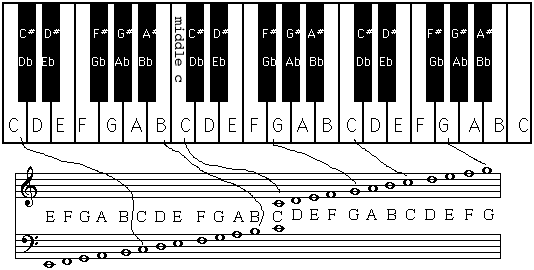
The numbers next to the staff will not be written. The figures show that only counting lines and spaces starting from the bottom. So the first line is the bottom line, and the fifth line is the top line. Within this staff notation will be placed and mark still.
At the beginning of each staff is always called a clef written. Clef in music school curricula commonly called the "key signature". Normally at the school known key / clef G, F, and C, but a commonly used is the key and lock G F. Many also say that G Key called "Treble", key F is called the "Bass", and the key of C is called "Tenor".
G/Treble :
F/Bass :

On the piano sheet music, used the combined treble and bass, can be called with the grand staff.In piano scores are sometimes added bass underneath again. Misguided what often happens is by mentioning the treble for the right hand, and bass for the left hand.
NOTATION
Notation using the alphabet, ranging from the letters A through G and then back to A. Basic scales are scales C (see basic music theory). If written in the staff to be like this:

Can be seen above, from C to G, then to A. The location of this notation is absolute, can not be changed. For example if you wrote the note G on the treble staff located on the second line.
If written in the grand staff, roughly like this:

Can be seen above, the tone of middle C and E as the far left who will be outside the staff. To write the above or below the staff to use help lines or lager line. Use of help lines can be 3-5 lines above or below the staff, depending on the composition of the song.
KEYBOARD/PIANO/PIANIKA/ORGAN
If you want to make it easier to learn musical notes, you should first understand the keys of the keyboard / piano / organ, do not need to learn to play, quite understood.
piano keys picture:

As the staff notnya absolute location, as well as on the piano, where the absolute notation, like this:

The position of the tones in it will not change, C remains a C, as well as others. Misguided is often the case, especially frequent music teachers in elementary and junior high schools are not writing C, D, E, F and so on but the writing do, re, mi, etc.. So for those of you who write on the keyboard / pianika / piano / organ with the notes do re mi, immediately removed, if you still need to replace it with C D E guide ff.
Because of its absolute, so we can conclude the keyboard and staff relationships to be like this:

For complete understanding of this, especially about the distances between the tones
DURATION NOTATION
When viewed on a staff can be seen there is notation
 . The notation is called the full notation (1). Once there is a full notation notation half (1 / 2), the notation a quarter (quarter), the notation eighth (eighth), and so on until 1 / 64.
. The notation is called the full notation (1). Once there is a full notation notation half (1 / 2), the notation a quarter (quarter), the notation eighth (eighth), and so on until 1 / 64.If drawn would be like this:
Not Full :
Not 1/2 :

Not 1/4 :

Not 1/8 :

diagrams into:

The notation can also be added to increase the duration of a half point. So for example, not 1 / 4 count one beat plus point =>
 Calculate duration 1 + (1 / 2 * 1) = 1 1 / 2. If you created a mathematical formula dotted notation = n + 1/2n.
Calculate duration 1 + (1 / 2 * 1) = 1 1 / 2. If you created a mathematical formula dotted notation = n + 1/2n.notation means that for example 1 / 2 is calculated as 2 tap, if the added point to be => 2 + (1 / 2 * 2) = 3 tap.
In note 1 / 8 there is the flag, if the flag is removed will be the notation 1 / 4.
So if you flag a note 1 / 8 =>


ect
For two similar notes may be combined if sequential writing. Suppose there are 2 not 1 / 8 consecutive

 , can to write
, can to write  .
. 
 =
=  .
.SIGN OF SILENCE
Apart from notation, there is also a sign of a break, that if the numbers are written in notation with the number 0 (zero). Just like notation, also called a silent sign naming the sign still full, half, quarter and etc.
Signs still full :

Sign of silent half (1 / 2) :

Signs quiet quarter (1/4) :

Sign of silent one-eighth (1/8) :

Signs silent sixteenth (1/16) :

Who still mistakenly identifies common is not / still full marks = 4 tap, not 1 / 2 = 2 tap, not 1 / 4 = 1 tap, ect. In fact 1 / 2 notation can be a tap, as well as notes 1 / 8. It all depends on the bar that is used.
